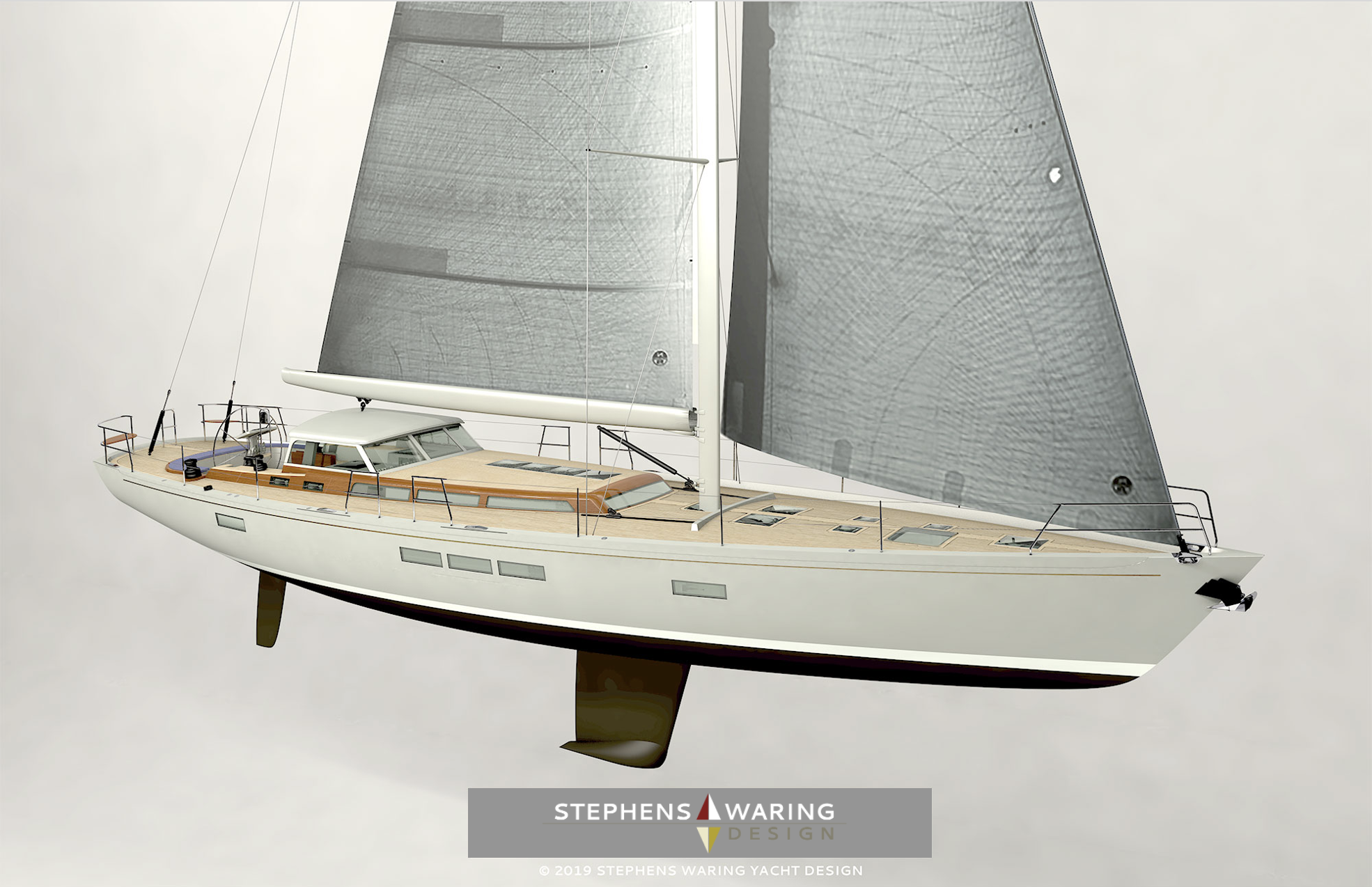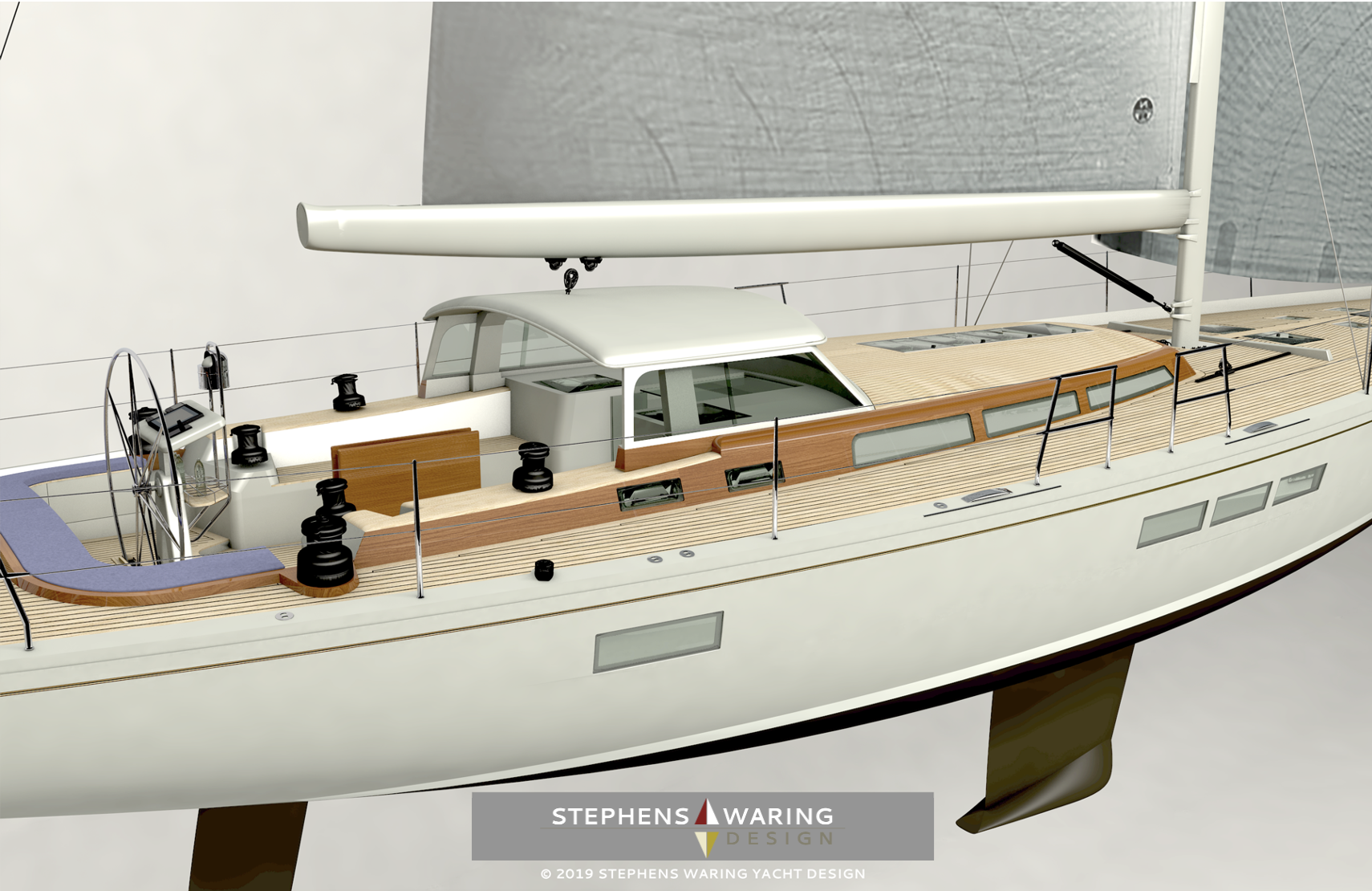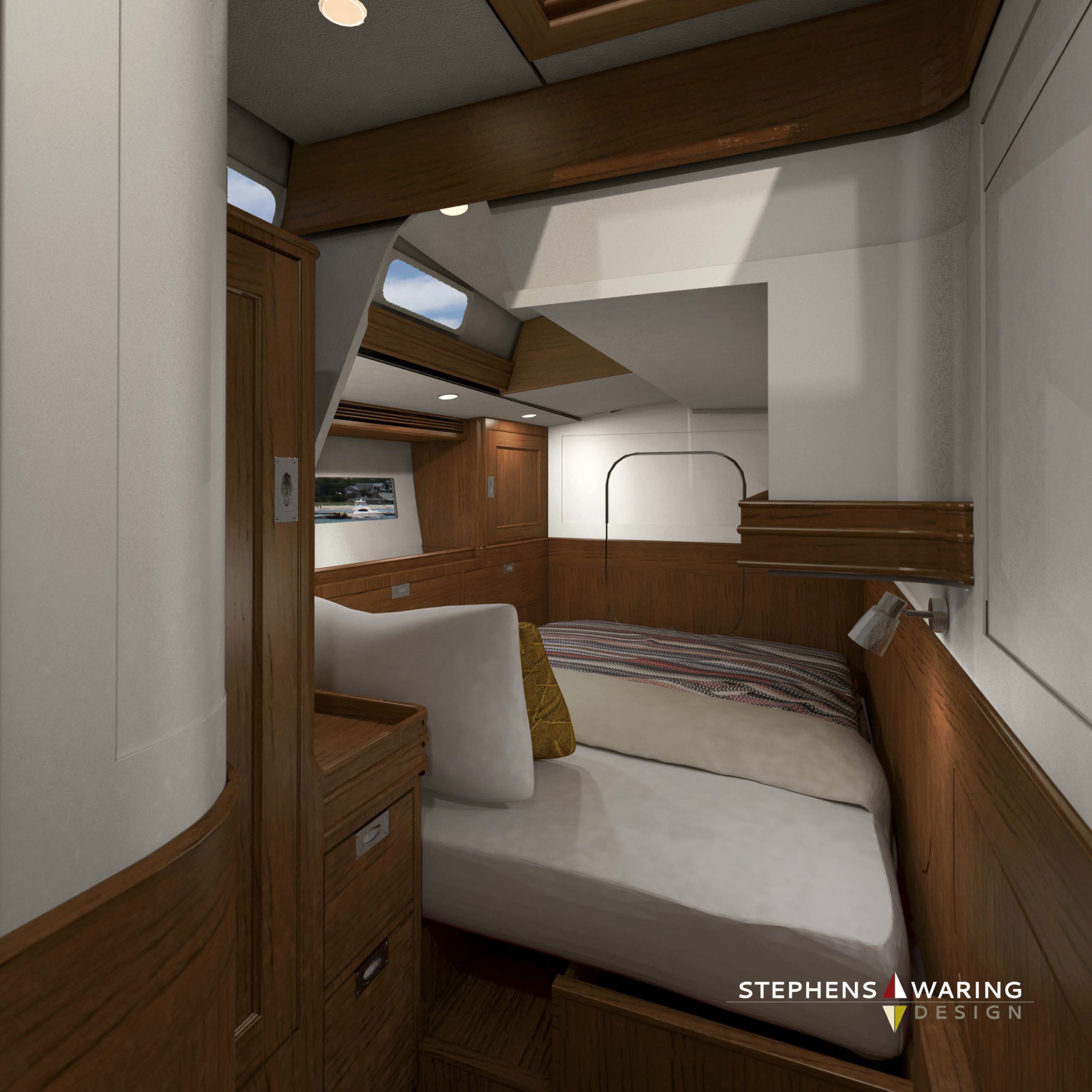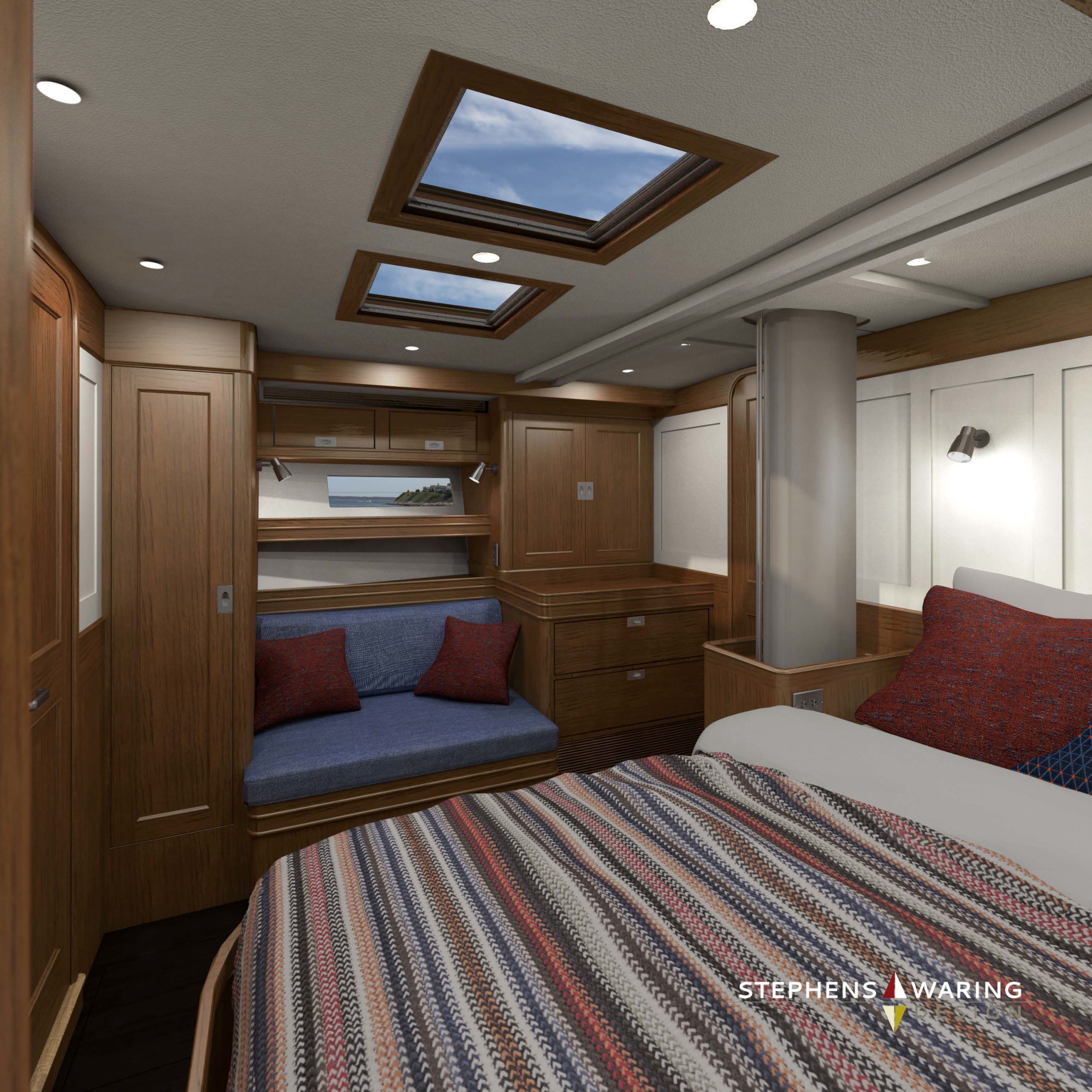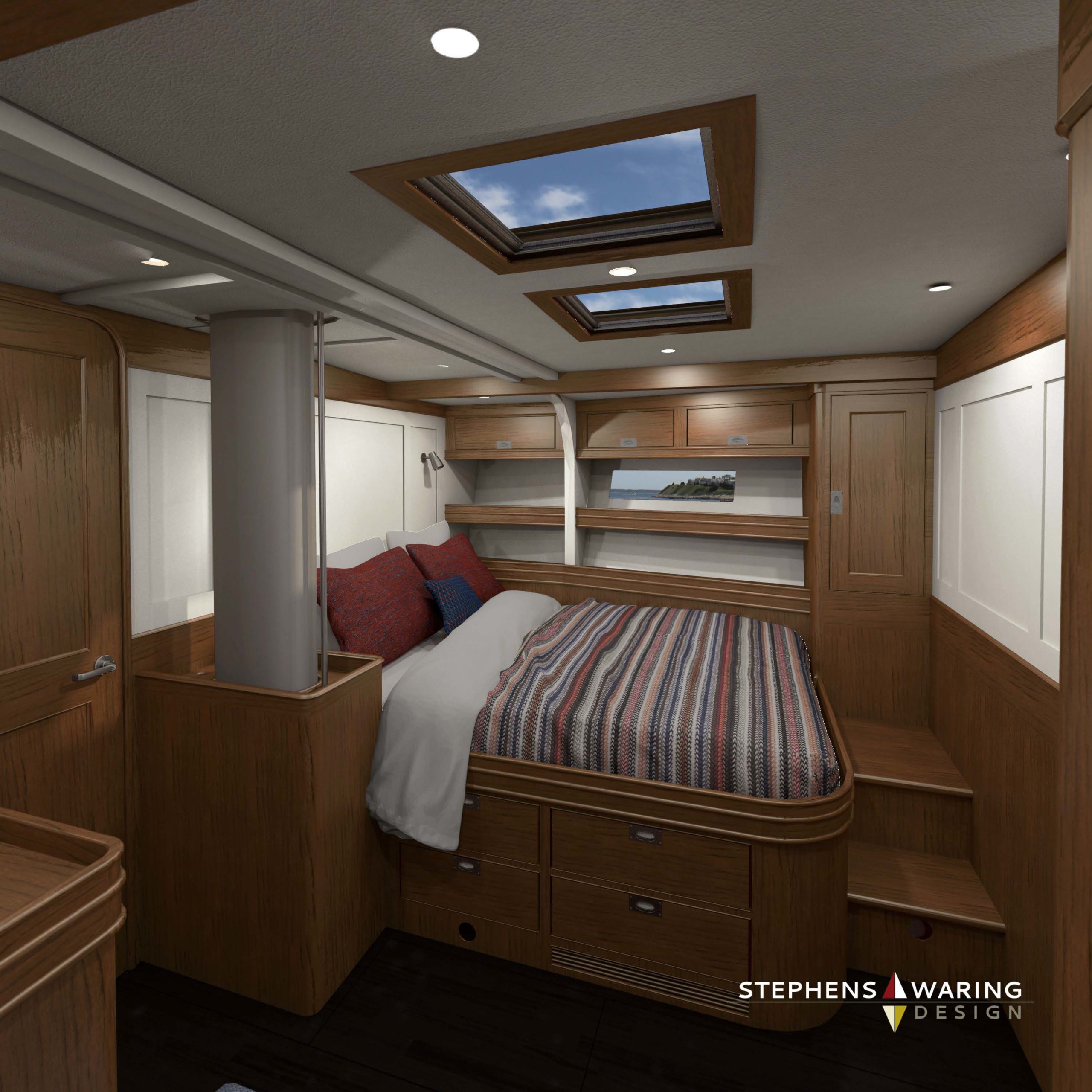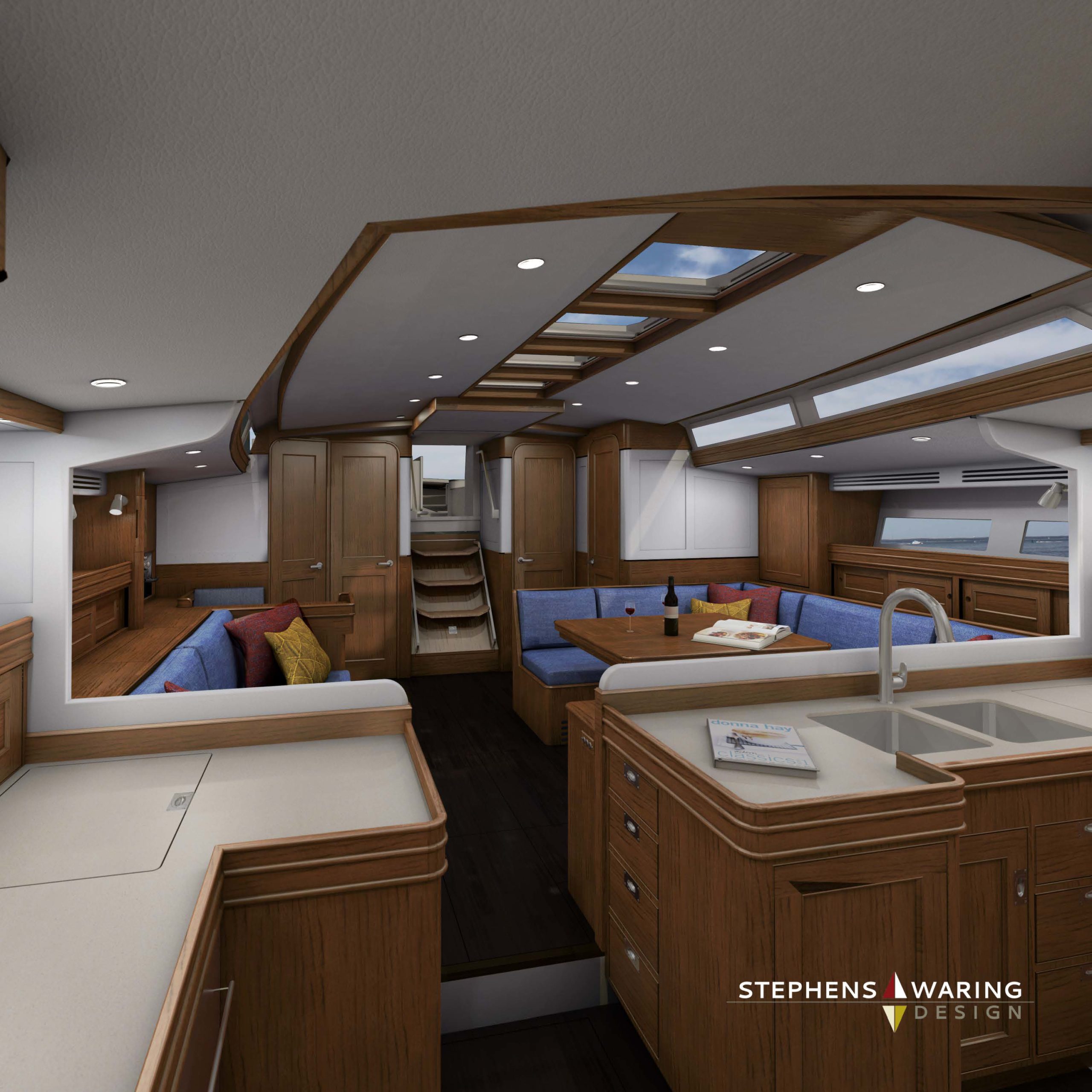As Cirrus nears her launch over at James Betts Enterprise —expected in July of 2023—we’re revisiting her conception to explore why she is what she is, and how her various characteristics fit the mission we defined with her owners during the design process.
A Fanciful Start
Typical of our projects, we are deeply involved with our clients through the design phases and build process, achieving the finest detail, to assure that we deliver exactly the boat they dream of. For Cirrus, this involved a few twists and turns, as the clients’ desires evolved during the design cycle. It was very productive—and a lot of fun for all.
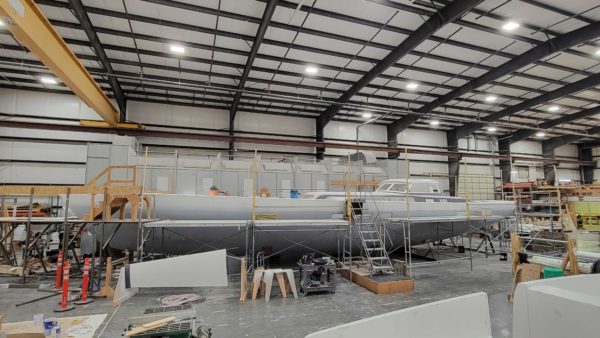
While the Cirrus’ architectural style celebrates mid-century yacht design, the deck, hull, mast, and boom are comprised of carbon-fiber composite structures. Photo credit: J Betts
The biggest twist was a shift in the exterior aesthetic of the yacht–originally aimed as a sleek Grand Prix-style Club Racer and taking a 180° turn towards Spirit of Tradition style. Our clients (a husband and wife team) were looking for a big step in luxury and style above their current cruising boat, a sporty 46-foot cruiser from a well-respected US brand. Their eyes had initially bent toward European brand, modern-style yacht—think Solaris, X-Yachts, and Swans—and we initially built a preliminary design for a sleek, spare, modern 57-footer with a plumb stem, wide wedge-shaped hull featuring a hint of a chine in the quarters. These choices would have made a great boat, but fate often takes us in new directions.
While seeking bids for this new yacht, our clients noticed from their home deck overlooking the beautiful waters of Rockport Harbor a parade of classic yachts sailing in and out of the iconic cove. At the end of the harbor sits the renowned boatyard of Rockport Marine, known for some of the most beautiful wooden boats in existence, including some of our design (Goshawk/Zemphira [hull, built]; W-46’s Zebra, Mustang, Arion, and Nashua [built]; Hoi An [maintained], to name a few).
The clients were especially smitten by the visiting yacht, Heroina, a gorgeous German Frers 80-footer designed by the master for his own use, and an edgy blend of classic and crisp clean modernity.
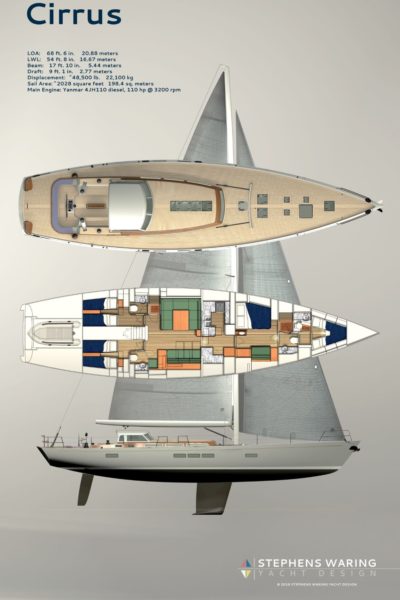
When we challenged a new design direction toward SoT, by adapting hull and deck style—essentially wrapping a new envelope around the proven interior and machinery arrangements already developed—we liked what we saw.
Over time their interest turned toward Spirit of Tradition design, and perhaps doing a bit of SoT racing. Their enthusiasm caused us to explore re-shaping the project into a Spirit of Tradition sailboat. The design brief had evolved from the three-cabin 57 to a four-cabin 63 to allow room for a professional crew while retaining a plumb-stemmed modern style hull and superstructure. When we challenged a new design direction toward SoT by adapting hull and deck style—essentially wrapping a new envelope around the proven interior and machinery arrangements already developed—we liked what we saw. We liked it a lot.
So did our clients.
With this newly shaped SoT-style, the yacht became 68 feet long overall, the waterline length slightly shorter, and a hull that eclipses the edgy plumb stem now with a classic spoon-shaped bow and a counter stern. There’s a hint of vee at hull centerline and a note of tumblehome at sheer— the yacht sports moderate overhangs in profile.
A Spirit of Tradition hull will exhibit vintage, classic, or some historic design vernacular—drawing elements of lineage in yachts (or working boats) from the past. Lots of inspiration can be found in the history of yacht architecture that exhibit ample diverse design styles. The SoT character that’s developed into sheer lines and profile, sections and overhangs works best if carefully balancing cohesive design elements from a specific inspiration or type of boat from the past. During the hull modeling process for Cirrus, the sheer-line acquires a bit more “swoop” both in profile and plan view as the transom becomes narrower to better suit the historic-inspired shape that’s developing. Final strokes of detail are made with the last bit of styling to the bulwark and decorative “waist” recess where the cove stripe lightly highlights the subtle sweeping shadow lines all the way to the stemhead. A substantial bulwark around the deck edge acquires classic detailing, with that waist and cove stripe, where the fairness sweeps into the quarters and bow.
Cirrus comes from a result of blending 40’s & 50’s era style—classic-inspired lines with hull shaping parameters that will also enhance modern performance—it’s a balancing act we love to maintain, it’s also the kind of work where we cut our teeth decades ago and it’s still a thrill to tease out the look of historic style while maintaining the promise of high-performance, ease of operation, and interior volume that modern-day boat owners demand.
Why Spirit of Tradition?
Why do boat owners gravitate to boats with vintage design inspiration blended with modern performance? What’s so satisfying about sailing aboard vessels with design drawn from historical context? No question that beautiful boats can be created with modern design aesthetics—so what brought Cirrus’s owners to this decision to eschew the spare, crisp look of their modern concept to embrace the more historical look of Cirrus’s design?
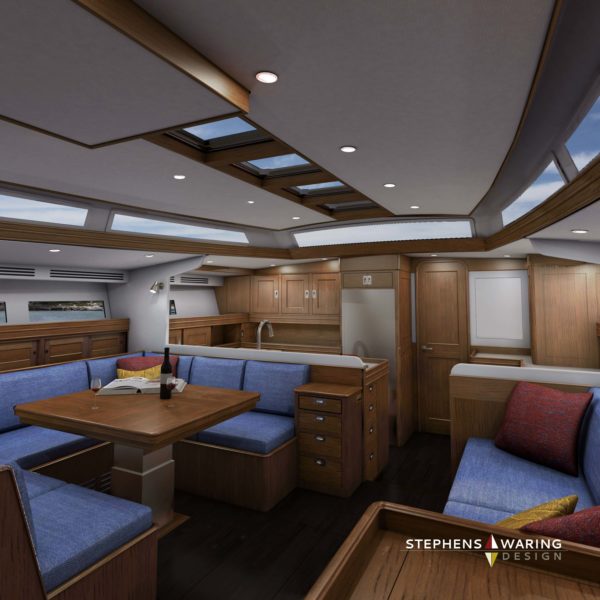
In the boat world, we can think of Spirit of Tradition as a “revival” style– a new expression of older design proportions, ornamentation, and style, but adapted and well-suited to modern living.
For many clients this may be a more esoteric to identify— there seems to be something about a sense of time or feelings remembered in a particular space or time of life. The marine environment and experiences we can enjoy while at sea can evoke an emotional connection to bygone eras; there’s a personal and visceral satisfaction, and meaning, found in sailing a boat that “fits” in that space. Cirrus’s owners have memories inspired by the fleet of beautiful old yachts — classic and vintage boats that comprise a special portion of Maine’s harbors.
For other boat-owners, the driving force may be found in racing– to join a fleet in classic-inspired yacht regattas — where sailors compete among a like-minded crowd, knowing the boats can play a big roll in bringing modern sailing excitement into boats that look vintage.
Spirit of Tradition style may offer a sense of connection and community among sailing enthusiasts who enjoy the benefits that modern design, advanced construction materials, and cutting edge sailing systems can bring into racing or cruising. The fundamental idea in SoT is a full embrace of new technology in sail design and sail materials, sailing hardware and gear, as well as foil shape and design of keels, rudders and other appendages… All while shaping the yacht into a form that derives from some sort of historical context.
What is architectural style?
Architectural style is a set of characteristics and features that make a building, a vessel, or other structure, notable or historically identifiable. Each architectural style includes a unique combination of elements such as form, aesthetics, method of construction, building materials, and perhaps regional character. It’s this combination of elements that allows us to differentiate between the various categories of architectural style.
When we think of Spirit of Tradition, we have always agreed that the designs must embody some historically identifiable link, particularly expressed in the shape and aesthetic exhibited in the design form of the hull and superstructure. Equally important, a SoT vessel must embrace modern development in materials, construction methods, mechanical systems and naval architecture science. Without the Spirit in development, we’re left with only Tradition. In land-based architecture, we talk about genres like Classical, Gothic, Greek Revival, and Gothic Revival. In the boat world, we can think of Spirit of Tradition as a “revival” style– a new expression of older design proportions, ornamentation, and style, but adapted and well-suited to modern living.
With Cirrus, we embraced the inspiration of classic American yachts of the mid-20th-century. We looked to such masters as Olin Stephens and K Aage Neilsen, as we developed Cirrus’ moderate proportions, modest overhangs, generous but not excessive beam, and broad but shapely stern. On deck, we drew details like the generously-rounded corners between cabin trunk and top from examples like Neilsen’s TIOGA series, and shaped the substantial hard dodger with period details like an overhanging visor.
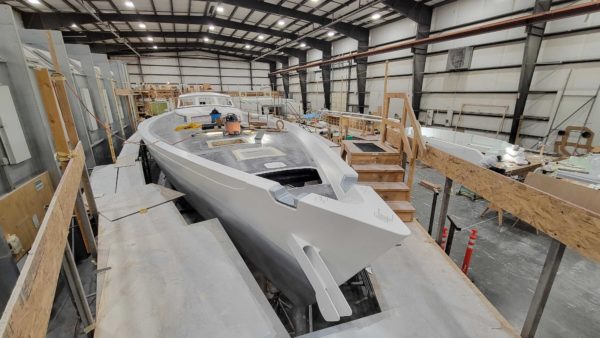
New and emerging technology allows advances and innovations for creating lighter, sturdier structures. Photo credit J. Betts
Building Materials and Construction
Historically, the materials used to build any structures (buildings, boats, etc.) were driven by whatever materials were abundant in the area. Wood, brick, and stone were used in buildings. Wood, hemp fiber, and iron were used in boats. These materials were employed for thousands of years.
As technology advances, other building materials emerge and become widespread. Steel, glass, and concrete in buildings. Steel and bronze, then fiberglass and carbon fiber, wood fiber, and plastics in boats. Better technology allows advances and innovations for creating lighter, sturdier structures.
We have seen these advances affect the innovations and evolutions that advance boat building from the traditional wood plank and clinch-nail to foam cores and hi-modulus fiber matrix. The tradition of such evolution of materials is intrinsic to the survival of refined engineering and advancement of construction approaches. Embracing such advances is at the heart of SoT architectural style.
Cirrus makes good use of modern high-modulus fibers and up-to-date construction methods. Hidden within their classic proportions, her cored carbon hull and deck are robust and lightweight. This solution allows us to keep performance on par with more stripped-out racing boats while providing a top level of creature comforts desired by the clients, like teak decks, washer/dryer, and full aircon, to name a few. Carbon mast, boom, and rigging assure longevity, stability, and sail-carrying power. Her luxurious wood-paneled interior is built on a lightweight cored-composite substrate. Her unique transom platform unfolds into a multipurpose deck, designed for cooking, lounging, accessing the water, and boarding the dingy.
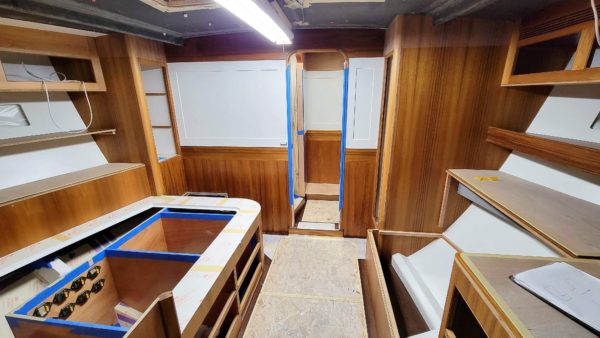
The design brief evolved from a three-cabin 57 to a four-cabin 68 to provide the option for a professional crew someday in the future. Photo credit J Betts
Age
The time for which a vessel was designed or built is another key component of architectural style. But in SoT design, we’re not creating replicas, or even above-the-water look-alikes– we are instead riffing on the motif of a particular classic vessel or type, and imbuing the new creation with historical influences as well as modern characteristics. This is key to Spirit of Tradition design principles, and distinctly different from more contemporary designs, where we lose the constraints to the historically identifiable aesthetic characteristics.
Age and context for when an older boat is designed and built is an obvious key piece when it comes to determining architectural style, and for division assignment in classic racing, it’s the essential element for Vintage and Classic divisions. However, in Spirit of Tradition design it is important to draw connection to historical context independent of the design/build date– the modern design and construction must link back to a historical reference or time, but impart modern influences upon that link.
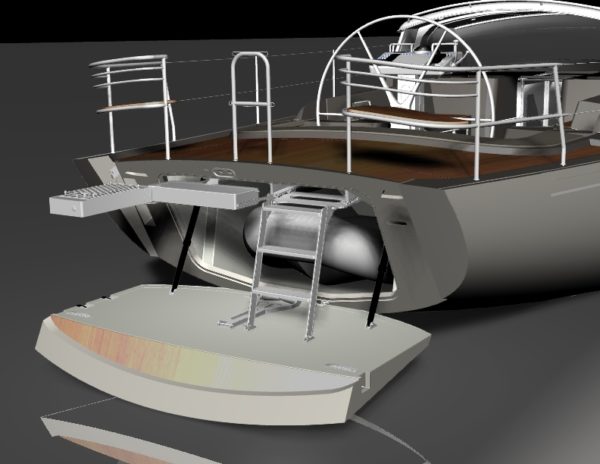
The transom platform we designed for Cirrus presents a significantly-sized aft “porch” for cooking, fishing, sitting, sunning, jumping off, climbing aboard from the water, or stepping aboard from the dinghy.
Design Aesthetic
Aesthetics are essential to understanding a vessel’s architectural style. The design of vessel structure includes understanding elements such as a boat’s defining lines, hull shape, superstructure massing, sail & rig arrangement, underbody design, and other criteria if necessary. Every vessel style has key features. Understanding how these design elements contribute to the structure is crucial to connecting with the architectural style of the vessel.
To help give Cirrus the mid-century aesthetic that was our inspiration, the form of her cabin superstructure and cockpit is styled in softly curved surfaces and radiused corners that play off themes of the time. This subtle massing of trunk and flush deck forward are nicely balanced with the gentle hull lines, and, when taken as a whole picture, the look can imply themes from a mid-century era. We include finishing touches in period details like a recessed cove stripe (not just a paint line), a recessed “waist” at her sheer bulwark, as well as swept “quarter-knees” and “breasthook” detailing her bulwarks. In our riff on tradition, we declined to place a wood cap rail on the bulwark, preferring the clean modern aesthetic and low-maintenance practicality of the simpler look.
Cirrus’s first sail will happen this spring in Anacortes, Washington, the home waters of Betts Boats, the builder we selected after exploring several options. We’ll dig deeper into what life aboard Cirrus will be like, as well as the build experience with a fantastic bespoke builder like Betts, in our next newsletter.
Cirrus Interior Design Gallery:
Designed by: Stephens Waring, Belfast, ME
Built by: James Betts Enterprises, Anacortes, WA
LOA: 68ft 6in (20.88m)
LWL: 54ft 8in (16.67m)
BEAM: 17ft 10in (5.43m)
DRAFT: 9ft 1in (2.77m)
DISPLACEMENT: 48,500lbs (22,100kg)
SAIL AREA: 2028sq ft (198 square meters)
POWER: 110hp Yanmar
SA/D RATIO: 24.4
D/LWL RATIO: 13
